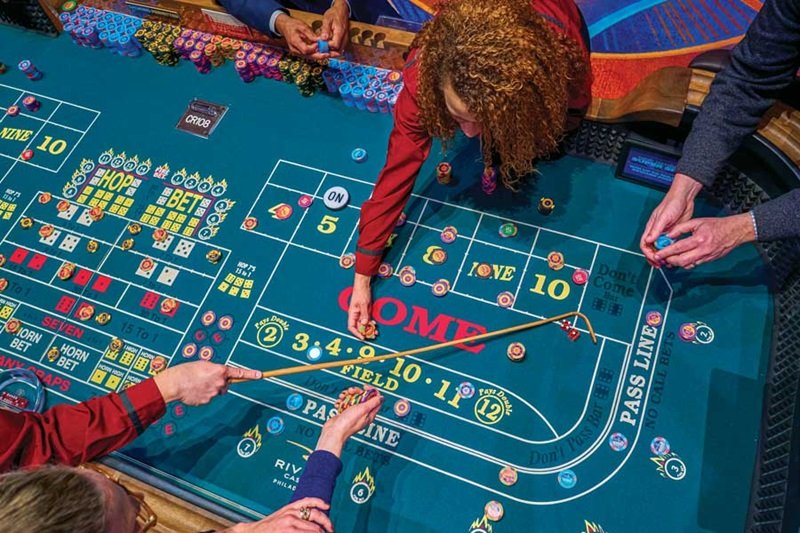Get to the bottom of one of the most famous gambling dice games and find out why it is so popular among players and spectators, and why it often surpasses even roulette.
Craps

Craps is one of the most popular gambling games (source: www.phillymag.com)
In this dice game, one or more players can participate as shooters. They throw two dice against the table’s barrier and wait for the resulting combination. Various bets can be placed, and thanks to the thrilling atmosphere and great betting odds, everyone enjoys this game full of tension and excitement. Additionally, the player can influence their total winnings, which further increases the game’s popularity.
Popular gambling games
History of Craps
The exact origin of this game is unknown, but it is believed to have evolved in the USA from a simpler Western European version. In 1805, Bernard Xavier Philippe de Marigny de Mandeville brought a dice gambling game to New Orleans, which did not catch on much among his peers. He then introduced it to the lower class, where it immediately gained significant popularity, starting its expansion. The game experienced a real boom during World War II. Gradually, Craps moved from the streets and bars to brick-and-mortar casinos, and in the second half of the 20th century, casinos outside the USA began to offer it as well. Since 2004, players can also play it online.
Game rules
Craps has very simple rules: each player (shooter) throws two dice against the table’s barrier. This throwing method is meant to prevent cheating by controlled throws. Before the dice are thrown, players bet on whether the resulting total will exceed the number 7 or not – Pass Line/Don’t Pass Line. If the result of the throw is 12, it is a draw, and the bets are returned to the players.
American and British version
Both variants of the game operate on the same principles and follow the same rules. The only differences are the slightly different terminology used during the game and the betting odds. The British version offers players better betting odds than the American one, and those that are completely unfavorable to the players are prohibited.
Game table
The Craps table in casinos and gaming rooms is usually operated by four people: a banker, two dealers, and a stickman. The banker, also known as the boxman, oversees the game, manages general operations, and distributes colored chips. The two dealers stand on either side of the banker and handle placing and paying out bets to the players. Opposite the banker stands the stickman, who moderates the game, collects the thrown dice with a wooden stick, and handles proposition and hard bets.
How to play Craps
The game consists of several rounds. The first throw of a new round is called the come-out roll, and if the player manages to throw a total of 7 or 11, called a win or natural, the game ends with the player’s win. If the player throws a total of 2, 3, or 12, called Craps, the game ends again, but with the player’s loss or, in the case of 12, a draw. If any other total is rolled, it becomes the point, and the game continues until a total of seven or the point total is rolled. If the point is rolled first, the next throw starts a new round. Conversely, if a total of 7 is rolled, the player loses (this is called seven-out), and the shooter becomes the player to his left. They can refuse and pass the dice to the next player in line.
Placing bets
Although players can place many different bets, there are only four basic types, and the entire game revolves around the number 7, as it has the most combinations possible with two dice. The basic bets are called Line Bets (in the American version as Pass Line and Don’t Pass Line, Come and Don’t Come, in the British version as Win Line and Don’t Win Line). Before the throw, the shooter decides whether to bet on Pass Line or Don’t Pass Line. Basic bets are paid out at 1:1 if won.
Pass Line
This bet is the most significant in the game, and if the shooter chooses it, the chip is moved to the appropriate place on the table. If the first throw totals 7 or 11, the player automatically wins. They lose with a total of 2 and 3 and draw with a total of 12. For other totals, a point is established, and the chip is moved to that number on the game board. At this point, the player must roll the point before rolling a total of 7. If 7 is not rolled for a long time and the player has a so-called hot hand, they can gradually cover all numbers (4, 5, 6, 8, 9, 10) and if they manage to roll any of these totals in the next throw, they win. When simultaneously placing bets on Pass Line or Come, the winning number’s bet (chip) is removed and replaced with a chip from the Pass Line or Come place. However, if a seven is rolled, all bets lose.
Don’t Pass Line
This bet is the opposite of the previous one. The win or loss in the first throw is determined the same way as in the Pass Line bet. However, if no winning totals of 7 and 11, losing totals of 2 and 3, or a drawing 12 is rolled, a point is again established, and the bet is moved to it. In this case, the player’s task is to roll a seven before rolling the point. In this bet, players can withdraw their bets from the table at any round before the throw.
Come and Don’t Come
These bets are almost the same as Pass Line and Don’t Pass Line. The difference is that they are placed only after the first throw. Bets on 7 or 11 win and those on 2 and 3 lose, with a total of 12 being a draw. If a point is rolled in the Come bet, the player must roll it before a seven to win, and vice versa in the Don’t Come bet. Players can also withdraw their bets from the table before any throw in this bet.
Odds bets
The basic bets listed above are further enhanced by odds or free bets. However, these bets may be limited in some establishments. Players can add these bets to their basic bet (in the same amount), and if they win, the payout is according to the mathematical ratio shown in the table below for Pass Line bets (in the opposite ratio for Don’t Pass Line bets).
|
Sum of two dice |
Mathematical ratios |
|
|
Pass Line |
Don’t Pass Line |
|
|
4 or 10 |
2:1 |
1:2 |
|
5 or 9 |
3:2 |
2:3 |
|
6 or 8 |
6:5 |
5:6 |
Other bets
This game allows players to place many other bets, which can be divided into one-roll bets and multi-roll bets that depend on specific outcomes.
- One-roll bets
- Proposition bets: These bets win or lose depending on whether the desired total is rolled, such as 2 (called Snake Eyes/Craps Aces), 12 (Craps), 2 or 12 (Hi-Lo), 3 (Ace Deuce), 11 (Yo), 2/3/12 (Craps), C & E as a combination bet where half is bet on Craps and half on Yo, Any seven as any sum of seven (sometimes referred to as Big Red). The payout ratio for these bets is 4:1.
- Field: In these bets, players bet that the next roll will total 3, 4, 9, 10, or 11, which are paid out at 1:1, or total 2 or 12, which are paid out at 2:1 or even 3:1.
- Horn bet: Bets placed on specific numbers 2, 3, 11, 12, and in the case of a win, the player is paid the payout ratio for one-quarter of the bet, with the remaining three-quarters lost. Players can also place an increased bet called Horn High, betting 5 units with 2 of them placed on one of the specified numbers.
- Whirl, World bet: Again, 5 units are bet, extending the Horn bet to include Any Seven. If a 2, 3, 7, 11, or 12 is rolled, the player wins one-fifth of the bet, paid out at the ratio for proposition bets of 4:1.
- Multi-roll bets: These bets remain active until an event occurs that causes the player to win or lose.
- Hard way: The sum must be formed by the same numbers, i.e., 2+2, 3+3, 4+4, 5+5. The player wins if the hard total is rolled before an easy total or a seven. Totals of 4 and 10 are paid out at 7:1 and 6 and 8 at 9:1.
- Easy way: The opposite of the Hard way bet, where the win occurs if a total of 4, 6, 8, or 10 is rolled before a 7.
- Big 6 and Big 8: Experienced players generally avoid these bets, and some operators do not allow them at all. The principle is that six or eight is rolled before a seven. The payout ratio in the case of a win is even, at 1:1. However, players can also bet on these totals directly with a higher payout ratio of 7:6.
- Place bets: These bets can be placed at any time during the game, and to win, the specified number must be rolled before a 7. The payout ratios are lower than the true mathematical odds listed above, except for numbers 6 and 8, which have a higher ratio of 7:6. For numbers 5 and 9, the payout ratio is 7:5, and for 4 and 10, it is 9:5.
- Buy and Lay bets: In this case, players bet on specific numbers and declare it as, for example, “Buy 6.” This bet wins if the specified number is rolled before a 7, and any winnings are paid at the true payout ratio minus a 5% commission (which goes to the game operator). The Lay bet is the opposite, where players bet that 7 will be rolled before the specified number.
Overview of bets and payout ratios
Line bets |
|||
|
Bet |
True odds |
Payout ratio |
|
|
Pass Line or Come |
251:244 |
1:1 |
|
|
Don’t Pass Line or Don’t Come |
244:251 |
1:1 |
|
|
Odds bets |
4 or 10 |
2:1 |
2:1 |
|
5 or 9 |
3:2 |
3:2 |
|
|
6 or 8 |
6:5 |
6:5 |
|
One-roll bets |
|||
|
Proposition bets |
|||
|
Bet |
True odds |
Payout ratio |
|
|
2 |
35:1 |
30:1 |
|
|
12 |
35:1 |
30:1 |
|
|
2 and 12 |
17:1 |
15:1 |
|
|
3 |
17:1 |
15:1 |
|
|
11 |
17:1 |
15:1 |
|
|
Craps |
8:1 |
7:1 |
|
|
C & E |
for Craps |
5:1 |
3:1 |
|
for 11 |
5:1 |
7:1 |
|
|
Any seven |
5:1 |
4:1 |
|
|
Field |
for 3, 4, 9, 10, 11 |
5:4 |
1:1 |
|
for 2 and 12 |
5:4 |
2:1 |
|
|
for 2 |
5:4 |
2:1 |
|
|
for 12 |
5:4 |
3:1 |
|
|
Horn bet |
for 2 or 12 |
5:1 |
27:4 |
|
for 3 or 11 |
5:1 |
3:1 |
|
|
Whirl bet |
for 2 or 12 |
2:1 |
26:5 |
|
for 3 or 11 |
2:1 |
11:5 |
|
|
for 7 |
2:1 |
0:1 |
|
Multi-roll bets |
|||
|
Hard way bets |
|||
|
Bet |
True odds |
Payout ratio |
|
|
4 or 10 |
2+2 or 5+5 |
8:1 |
7:1 |
|
6 or 8 |
3+3 or 4+4 |
10:1 |
9:1 |
|
Big 6 and Big 8 |
6:5 |
1:1 |
|
Place bets |
|||
|
Bet |
True odds |
Payout ratio |
|
|
4 and 10 |
2:1 |
9:5 |
|
|
5 and 9 |
3:2 |
7:5 |
|
|
6 and 8 |
6:5 |
7:6 |
|
Buy bets |
|||
|
Bet |
True odds |
Payout ratio |
|
|
4 and 10 |
2:1 |
2:1* |
|
|
5 and 9 |
3:2 |
3:2* |
|
|
6 and 8 |
6:5 |
6:5* |
|
Lay bets |
|||
|
Bet |
True odds |
Payout ratio |
|
|
4 and 10 |
1:2 |
1:2* |
|
|
5 and 9 |
2:3 |
2:3* |
|
|
6 and 8 |
5:6 |
5:6* |
|
* + 5% commission to the operator in case of a win
Where to play Craps
Nowadays, players can enjoy this popular dice gambling game both in person at gaming rooms and casinos and online casinos or mobile apps. Online Craps additionally allows for betting with real money or playing just for fun. This way, players are not limited by the presence of a gaming room or casino in their vicinity and can enjoy the thrill of gambling anytime and anywhere.
Try your luck at an online casino
Frequently asked questions
1️⃣ What is Craps?
It is a gambling dice game where the player (shooter) throws two dice against the table’s barrier and places bets on their total.2️⃣ What bets are available in Craps?
In the game, players bet on 4 basic bets: Pass Line/Don’t Pass Line and Come/Don’t Come, which revolve around the number 7. However, they have many other bets available to complement these four (described above).
3️⃣ Where can you play Craps?
As the most popular dice game, it can be played both in gaming rooms and casinos, as well as online on websites or mobile apps, either for free or for real money.







Discussion, comments and your experiences
Share your opinion, ask a question, or offer advice to others in the moderated discussion. Editors also participate, but they respond based on their current availability. If you expect a direct response, we recommend using email communication instead.